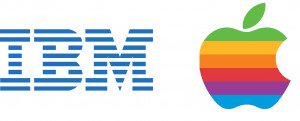By Anca Gagiuc on July 25, 2014 in Technology
Apple and IBM share a past, and recently announced plans to share a future, as both look to continue growth in their respective market niche. The news brought back memories from 30 years ago, when a partnership between the two companies was unimaginable.
The goal of the partnership, according to an Apple press release, is to “redefine the way work will get done, address key industry mobility challenges and spark true mobile-led business change.”
The move acknowledges the unique strengths of each company – IBM will contribute its big data and analytics expertise and Apple will offer the “elegant user experience of iPhone and iPad.”
The enterprise market is not untouched territory for Apple, as plenty of Fortune 500 businesses have already deployed iOS devices. The current corporate customer list includes NASA, Nestle, Deutsche Bank, American Airlines, Cisco Systems, Johnson Controls, Luxottica, and GE.
The BYOD trend (bring your own device) in the workplace has been beneficial to Apple as companies have gradually allowed employees to use their personal devices for work email and to access needed data.
IDC research firm shows that iPhones accounted for 82 percent of smartphones in use at U.S. corporations and 36 percent globally, while iPads accounted for 73 percent of tablets in the U.S. corporate environment and 39 percent around the world.
A new category of mobile apps will become available, debuting in 2015, announced the two companies. These will be tailored to meet the needs of specific industries like “retail, healthcare, banking, travel, telecommunications, and insurance.” IBM’s cloud infrastructure will be heavily used in correlation with Apple’s iCloud service. AppleCare for Enterprise will be added to the customer service domain, providing IT departments and users 24/7 support.
“We’re good at building a simple experience and in building devices,” Tim Cook said in an interview with Recode. “The kind of deep industry expertise you would need to really transform the enterprise isn’t in our DNA. But it is in IBM’s.”
From an objective perspective this moment represents the reach of maturity on the technology market and Cook seems to state just that in an interview with CNBC : “We knew we couldn’t do it alone,” and in the entire industry Apple found that “kindred spirit” in IBM.
Ginni Rometty, IBM’s CEO stands by his statement: “We are delighted to be teaming with Apple, whose innovations have transformed our lives in ways we take for granted, but can’t imagine living without.”
Probably the first thing that comes to mind when putting these two names together is the famous attack Apple launched against IBM through the iconic “1984” commercial, describing IBM as the Big Brother who stands by the status quo while the Macintosh was the way to remain free. Almost a decade later, IBM and Apple attempted to form an alliance that would rival Microsoft Windows.
Taligent, the OS, resulted from the partnership – but three years later the collaboration came to an end. The upside was that the failure of Taligent was prompted Apple to acquire Next and bring back Steve Jobs.
Two other partnerships were attempted between Apple and IBM in the ‘90s. Kaleida – an attempt to innovate interactive CD-ROMs – died after a few years. The AIM alliance worked on developing a new computing standard, based on PowerPC architecture, that resulted in PowerPC chips Apple used in the Macintosh line in 1994-2006.
This time around, the collaboration has the potential for huge gains for both sides (besides market share gain for both companies immediately after the announcement). IBM gives Apple entry into the business space, while Apple gives IBM a massive untapped user base in the commercial business.
This partnership will put a lot of pressure on Blackberry, once the industry leader in enterprise mobile, and on Microsoft, who announced to steer away from selling software. The question is if the rivalry between Apple and IBM is really turning into responsible partnership or it’s a ‘history repeating itself’ kind of move.


